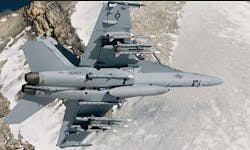New Article
The F-16 MTCs can simulate the fighter aircraft’s block 40/42 or 50/52 configurations. They also help F-16 pilots practice how to determine the orientation of air-to-air targets. "Pilots will be immersed in high-definition, dynamic training scenarios that will enable them to practice air-to-air and air-to-ground missions under any condition that might be encountered during actual flight," says Leonard Genna, president of L-3 Link.
The Boeing Co. is providing instructor and operator stations for the L-3 Link F-16 MTC installations, as well as the mission observation, brief, and debrief systems. L-3 Link's contract to provide F-16 MTCs includes options for as many as 20 simulation and training systems, which model all of the fighter aircraft’s weapon systems and ordnance.
F-16 pilots use the MTCs for basic and advanced pilot mission training, tactics validation, and mission rehearsal. Each MTC has L-3 Link’s next-generation HD World visual and display simulation technologies that help create realistic training conditions. HD World’s visual display component, SimuSphere HD, will provide each F-16 MTC training device with an immersive field-of-view that can display out-the-window imagery at 20/40 visual acuity, L-3 Link officials say.
Each of the four simulators in the F-16 MTC has a 360-degree visual display, synthetic environment, instructor and operator station, and brief and debrief station. The simulators can be operated individually or linked together to provide four-ship training within the MTC and in the Air Force Distributed Missions Operations (DMO) network.
For more information contact L-3 Link online at www.link.com.
Related stories
-- Visiongain: military simulation and virtual training market to reach $8.75 billion this year;
-- CAE wins multiple commercial flight simulation and training contracts.
